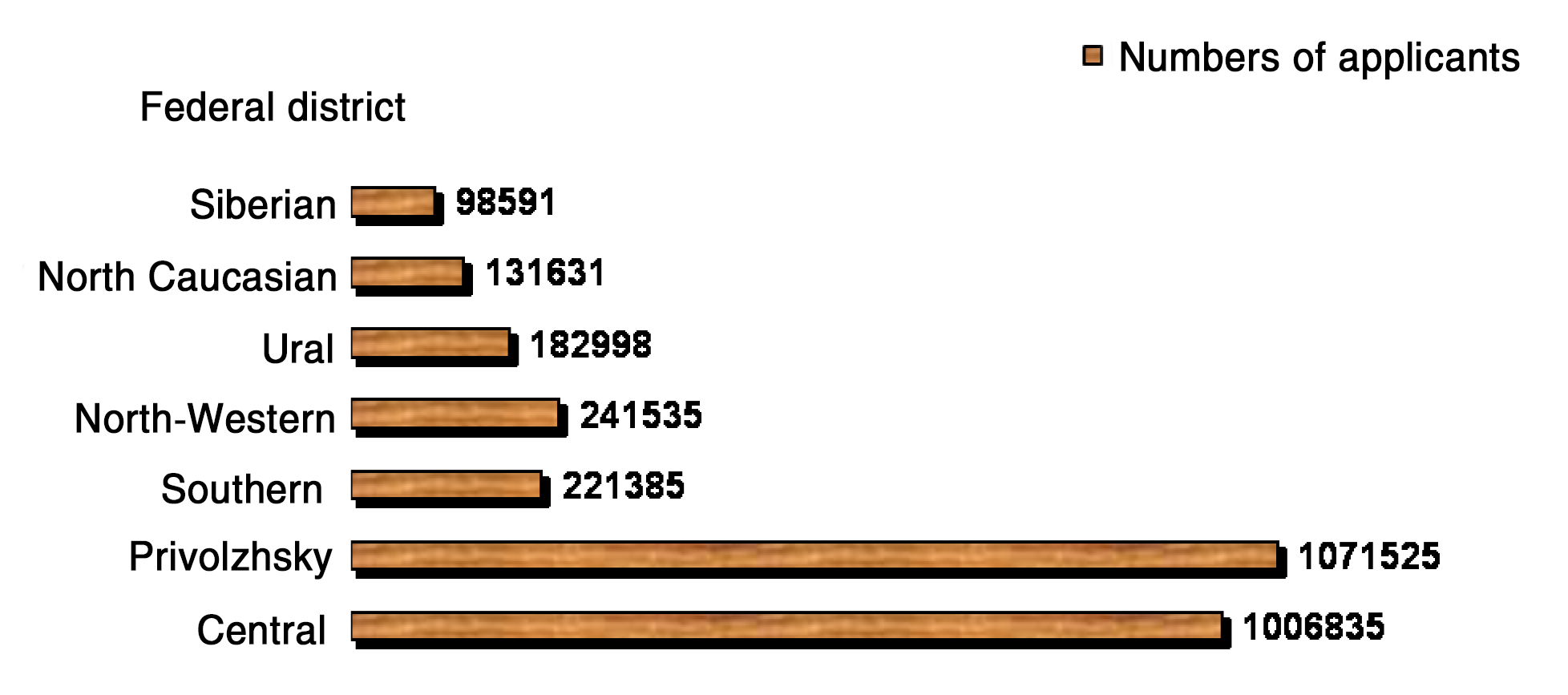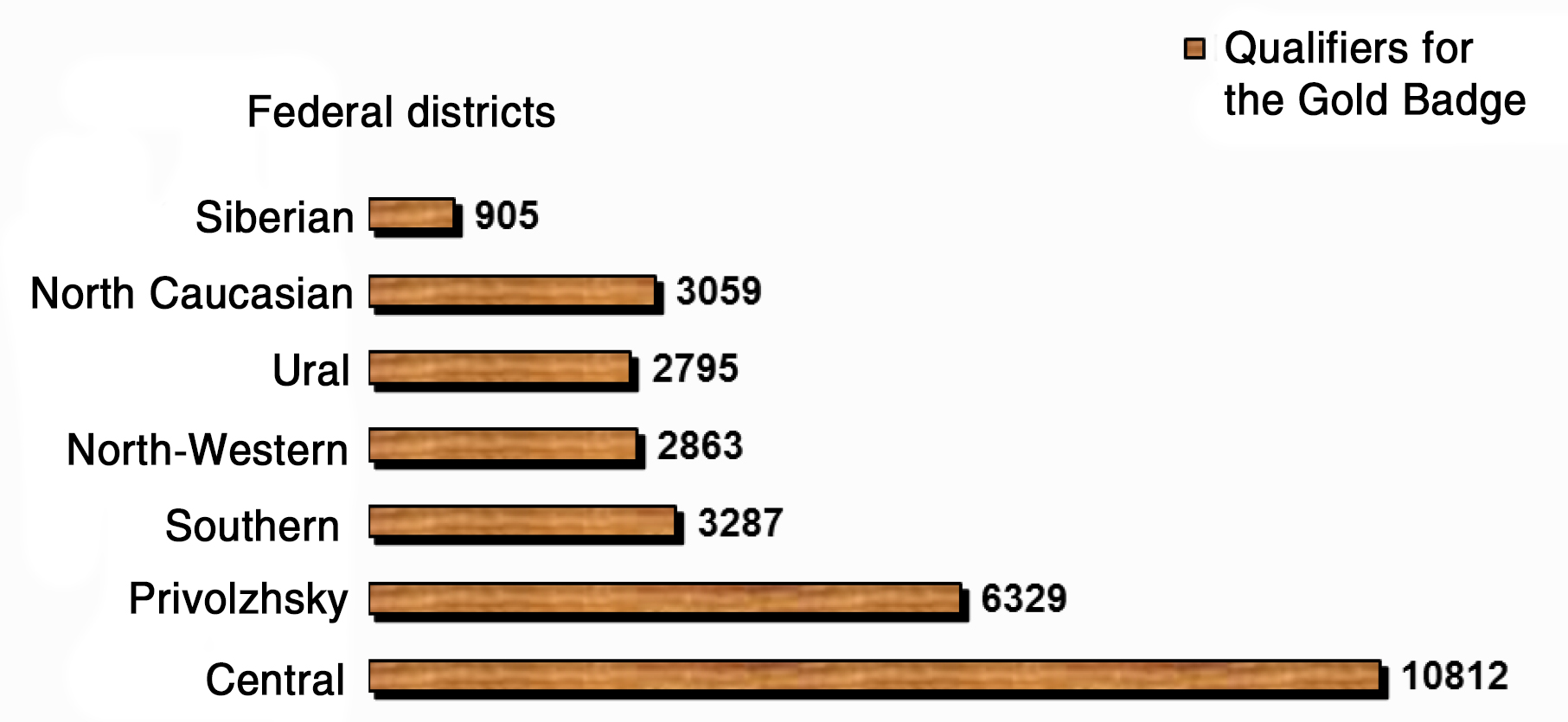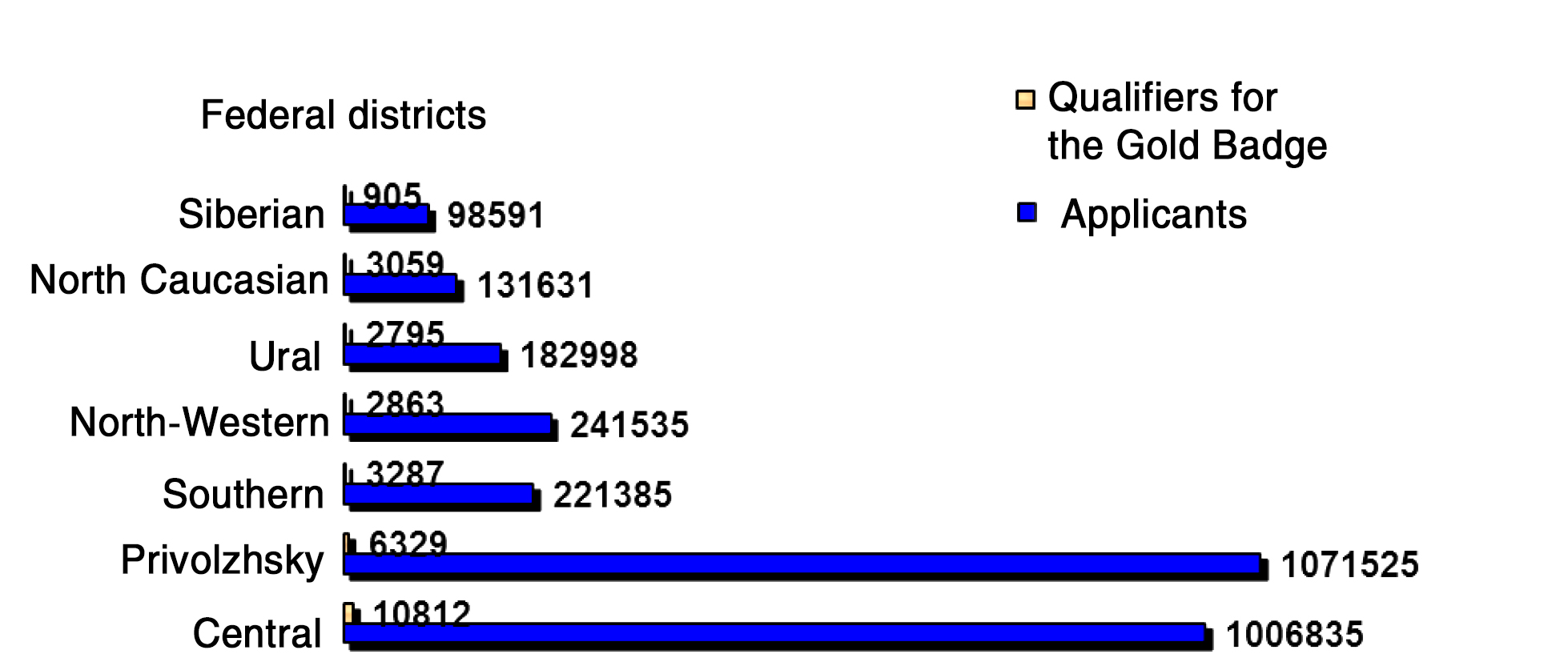GTO complex role in national physical culture and sports sector
Фотографии:
ˑ:
Dr.Hab., Professor S.I. Filimonova1
Dr.Hab., Associate Professor I.A. Sabirova2
PhD T.S. Grishina2
S.N. Fedoryachenko3
1Moscow City Pedagogical University, Moscow
2Voronezh State Institute of Physical Culture, Voronezh
3Higher School of Economics, Moscow
Keywords: Russian Physical Culture and Sports “Ready for Labour and Defence” (GTO) Complex, territorial entities of RF, national physical culture and sports sector.
Background. For the 16 years of the new millennium, the national physical culture and sports sector of the Russian Federation has seen major reforms in many aspects including the financial and technical provisions and the institutional, research and promotional domains of the physical culture and sports in the country. Good progress was made in the projects to improve financial, technical, regulatory, institutional, educational, research and sport promotion aspects of the national physical culture and sports sector.
Due initiatives were taken pursuant to the National Physical Culture and Sports Development Strategy of the Russian Federation for the period up to 2020 and the Physical Culture and Sports State Development Program of the Russian Federation to lure broader public strata to physical culture and sports on a systemic basis albeit the actual public commitment rates still leave much to be desired.
To further reinforce the national policies in the physical culture and sports sector and support the ongoing efforts to establish an efficient national physical education system for the human resource mobilising and people’s health improvement purposes, the Russian Physical Culture and Sports “Ready for Labour and Defence” (GTO) Complex was reinstated and put into effect on September 01, 2014 pursuant to the Presidential Decree #172 of March 24, 2014 [12, 8].
The Russian Federation Government Regulation #540 of June 11, 2014 approved a GTO Complex Statute that provides for the Complex tests being designed to include 11 age group stages (for the qualifiers from 6 to 70 plus years of age) with each stage offering standard tests of three difficulty levels (to qualify for the Gold, Silver or Bronze GTO Badges); the tests being designed to meet the relevant governmental requirements to the people’s physical fitness rates as verified by the relevant age- and class-specific optional or mandatory tests; and including the relevant recommendations on the weekly physical activities [2. 3].
The GTO Complex implementation plan was designed to include three interrelated stages. As things now stand, the third stage of the plan is being implemented to lure as many people as possible to the GTO Complex tests in every territorial entity of the Russian Federation.
Objective of the study was to make a comparative analysis of the public commitment for the GTO Complex tests at its second implementation stage.
Methods and structure of the study. Subject to the analysis were the statistical data on the numbers of applicants for and qualifiers in the GTO Complex tests at its second implementation stage, with the basic study data obtained from the official website www.gto.ru.
Study results and discussion. As of June 2016, formally registered on the GTO test website were 3.2 million people from 86 territorial entities of the Russian Federation. Given on Figure 1 hereunder are the numbers of applicants broken down by federal districts of the Russian Federation.

Figure 1. Numbers of applicants for the GTO Complex tests by federal districts of the RF, as of June 2016
As demonstrated on Figure 1, the Privolzhsky Federal district was a leader by the number of applicants that accounted for 3.7% of the total population; going second was the Central Federal district with the applicants estimated at 2.6% of the total population.
Given on Figure 2 hereunder are the numbers of successful qualifiers for the Golden GTO Complex Badges by districts of the RF, as of June 07, 2016.

Figure 2. Qualifiers for the Gold GTO Complex Badge by the federal districts of the RF, as of June 07, 2016
It should be noted that, despite the highest number of applicants in the Privolzhsky Federal district, the Central Federal district was the first in the number of successful qualifiers for the Gold Badge (n=10,812), with the following breakdown by its regions: 2113 in the Moscow region; 2065 in the Belgorod region; and 1448 in the Voronezh region; lagging behind in the success rates were the Yaroslavl region (n=20), Orel region (n=59), and Kaluga and Tula regions (n=66 each). Leading in the Privolzhsky Federal district by the numbers of successful GB qualifiers were the Republic of Tatarstan (n=595); whilst the Krasnodar Territory (n=1712) was a leader in the Southern district; Saint Petersburg city (n=1160) was a leader in the North-Western district; the Sverdlovsk region (n=1347) was leading in the Ural district (n=2795); Republic of Dagestan (n=948) was the first in the North Caucasian district; and the Irkutsk region was the first in the Siberian district.
Comparative analysis of the GTO test progress rates by districts and regions of the RF made it possible to rank them as follows. The top five regions included the Moscow region of the Central district with its 423,092 applicants for the tests versus 2113 Gold Badge qualifiers making up 0.5% of the applicants; the Belgorod region in the Central district with its 136,750 applicants versus 2065 Gold Badge qualifiers making up 1.51% of the applicants; the Krasnodar region in the Southern district with its 41579 applicants versus 1712 Gold Badge qualifiers making up 4.12% of the applicants; the Voronezh region in the Central district with its 66,110 applicants versus 1448 Gold Badge qualifiers making up 2.19% of the applicants; and Moscow city in the Central district with its 62,298 applicants versus 1435 Gold Badge qualifiers making up 2.3% of the applicants.
Lagging behind by the numbers of the Gold Badge qualifiers among regions of the RF were the Republic of Ingushetia in the North Caucasian district with its 461 applicants versus only 1 Gold Badge qualifier (0.22% success rate); the Nenets Autonomous District in the North-Western district with its 1091 applicants versus only 3 Gold Badge qualifiers (0,27% success rate); in the Siberian district coming last were the Republic of Altai with its 5004 applicants versus only 6 Gold Badge qualifiers (0.12%) and the Zabaikalye Territory with 9 Gold Badge qualifiers out of 5694 applicants (0.16%); plus the Jewish Autonomous region in the Far Eastern district with its 11 Gold Badge qualifiers out of 681 applicants (1.62%): see Figure 3.

Figure 3. Numbers of the Golden Badge qualifiers versus the applicants by the federal districts of the RF
Conclusion. The study data and analyses show that the GTO Complex implementation project makes some success across federal districts and regions of the RF with a notable public commitment growth trend. However, the study data also showed generally low primary fitness levels of the applicants at the second stage of the GTO project implementation albeit it should be noted that the second stage is mostly designed to test the school population subject to compulsory physical education. Some issues related to the self-reliant training of broader population for the GTO tests are still contradictory as yet for the reason that the relevant recommendations as such cannot provide enough motivation for the self-reliant practices, plus no data are available on the primary physical statuses of the qualifiers for the tests. New comprehensive surveys are recommended and the latent resources still need to be mobilized to obtain new GTO test progress data.
References
- Andryushchenko L.B. Pedagogicheskaya sistema formirovaniya gotovnosti k razvitiyu fizicheskoy kultury u studentov selskokhozyaystvennykh vuzov. Dis. dokt. ped. nauk [Pedagogical system of formation of readiness for development of physical culture in agricultural university students. Doctoral diss. (Hab.)]. VSAPC publ., Volgograd, 2006.
- Andryushchenko L.B. Monitoring fizicheskogo razvitiya studencheskoy molodezhi Volgogradskoy oblasti [Monitoring of physical development of students of the Volgograd region]. Vestnik Volgogradskogo gosudarstvennogo meditsinskogo universiteta, 2005, no. 2, pp. 31-34.
- Germanova L.A., Germanov G.N., Vasenin G.A. Organizatsiya dvigatelnogo rezhima detey starshego doshkolnogo vozrasta v aspekte podgotovki k sdache norm kompleksa GTO I stupeni [Organization of senior preschool children's motor activities within training for stage I GTO complex tests]. Fizicheskaya kultura, sport – nauka i praktika. 2016, no. 2, pp. 14-17.
- Evseev S.P., Evseeva O.E., Pelikh E.Y., Filimonova S.I. O realizatsii vserossiyskogo fizkulturno-sportivnogo kompleksa gto sredi studentov spetsialnykh meditsinskikh grupp [Implementation of Russian physical culture and sports GTO complex among special health group students]. Kultura fizicheskaya i zdorovye. 2015, vol. 51, no. 1, pp. 6-9.
- Kazantinova G.M., Andryushchenko L.B., Charova T.A. Zdorovy obraz zhizni v professionalnoy deyatelnosti spetsialista. Ucheb. posobie dlya stud. s.-kh. vysshikh uchebnykh zavedeniy, obuchayushchikhsya po distsipline «Fizicheskaya kultura» [Healthy lifestyle in specialist professional activity. Study guide for agricultural university students majoring in Physical Education]. RF M-ry of agriculture, Department of science technology policy and education, Volgograd State Agricultural Academy Volgograd, 2009.
- Kompleks mer po stimulirovaniyu razlichnykh vozrastnykh grupp naseleniya k vypolneniyu normativov i trebovaniy Vserossiyskogo fizkulturno-sportivnogo kompleksa «Gotov k trudu i oborone» (GTO) na 2015-2017 gody [Set of measures to stimulate different age groups to implement standards and requirements of Russian physical culture and sports "Ready for Labour and Defence" (GTO) complex in 2015-2017.].
- Metodicheskoe posobie «Organizatsiya meditsinskogo soprovozhdeniya vypolneniya normativov Vserossiyskogo fizkulturno-sportivnogo kompleksa “Gotov k trudu i oborone” (GTO)», utverzhdeno Prezidiumom Rossiyskoy Assotsiatsii po sportivnoy meditsine i reabilitatsii bolnykh i invalidov Protokolom # 12 ot 21 noyabrya 2014 g. [Toolkit "Organization of medical support of implementation of Russian physical culture and sports GTO complex standards, approved by the Presidium of the Russian Association of sports medicine and rehabilitation of sick and disabled Protocol № 12 dated November 21, 2014]
- Postanovlenie Pravitelstva Rossiyskoy Federatsii ot 11 iyunya 2014 g. # 540 «Ob utverzhdenii Polozheniya o Vserossiyskom fizkulturno-sportivnom komplekse «Gotov k trudu i oborone» (GTO)» [Russian Federation Government Resolution dated June 11, 2014 № 540 "On Approval of Russian physical culture and sports "Ready for Labour and Defence" GTO complex"].
- Prikaz Ministerstva sporta Rossiyskoy Federatsii ot 18 fevralya 2015 g. # 144 «Ob utverzhdenii Poryadka nagrazhdeniya grazhdan Rossiyskoy Federatsii znakom otlichiya Vserossiyskogo fizkulturno-sportivnogo kompleksa «Gotov k trudu i oborone» (GTO) i prisvoeniya im sportivnykh razryadov» [Order of RF Ministry of Sports dated February 18, 2015 no. 144 "On Approval of the Procedure for awarding Russian citizens with merit badge of Russian physical culture and sports "Ready for Labour and Defence" GTO complex and assigning them sports categories"].
- Rasporyazhenie Pravitelstva Rossiyskoy Federatsii ot 30 iyunya 2014 g. # 1165-r «Ob utverzhdenii plana meropriyatiy po poetapnomu vnedreniyu Vserossiyskogo fizkulturno-sportivnogo kompleksa «Gotov k trudu i oborone» (GTO)» [RF Government Order dated June 30, 2014 no. 1165-r "On approval of the action plan for the phased introduction of the Russian physical culture and sports "Ready for Labour and Defence" GTO complex"].
- Sabirova I.A., Ilyin M.A., Zozulin S.A. Podgotovka k ispyitaniyam kompleksa «Gotov k trudu i oborone» (GTO) v razdele strelba iz pnevmaticheskoy vintovki ili elektronnogo oruzhiya [Training for the "Ready for Labor and Defense" (GTO) complex tests in air rifle of electronic weapons shooting]. Vseros. nauch.-prakt. konf. "Aktualnye problemy vnedreniya kompleksa GTO i razvitiya massovogo sporta" [Proc. res.-pract. conf. "Actual problems of GTO complex implementation and mass sports development"]. Belgorod: SRU «BSU» publ., 2016, pp. 201-205.
- Ukaz Prezidenta Rossiyskoy Federatsii ot 24 marta 2014 g. # 172 «O Vserossiyskom fizkulturno-sportivnom komplekse «Gotov k trudu i oborone» (GTO)» [Presidential Decree dated March 24, 2014 № 172 "On Russian physical culture and sports "Ready for Labour and Defence" GTO complex"].
- Filimonova S.I. Realizatsiya proekta Vserossiyskogo fizkulturno-sportivnogo kompleksa v uchebny protsess i primernaya programma distsipliny «Fizicheskaya kultura» (statya) [The Russian physical culture and sports complex project implementation in the learning process and exemplary Physical Education curriculum (article)]. Mater. Vseros. nauch.-prakt. konf., posv. 70-letiyu Kolledzha fizicheskoy kultury i sporta, ekonomiki i tekhnologii SPBGU «Fizicheskaya kultura i sport v sisteme obrazovaniya Rossii: innovatsii i perspektivyy razvitiya» [Proc. res.-pract. conf., dedicated to 70th anniversary of Physical Education and Sport, Economics and Technology College under St. Petersburg State University "Physical Culture and Sports in the Russian education system: innovations and development prospects]. St. Petersburg, 4-7.11.2014, pp. 243-248.
Corresponding author: filimonovasi@mail.ru
Abstract
The study considers the GTO Complex second-stage implementation issues. Objective of the study was to rate the popular commitment to the GTO Complex test by a comparative analysis of the second-stage implementation reports. Subject to the analysis were the statistical data on the numbers of applicants for the GTO Complex tests and successful qualifiers at its second implementation stage, with the basic study data obtained from the official website www.gto.ru. The study data and analysis demonstrated a general progress of the GTO Complex implementation across the RF regions as verified by the popular commitment rates. However, the study data also showed generally low primary fitness levels of the applicants at the second stage of the GTO project implementation albeit it should be noted that the second stage is mostly designed to test the school population subject to compulsory physical education at schools. A number of issues related to the self-reliant training of a broader population for the GTO tests are still contradictory as yet for the reason that the relevant recommendations as such cannot provide enough motivations for the self-reliant practices, plus no data are available on the primary physical statuses of the qualifiers for the tests. New comprehensive surveys are recommended and the latent resources still need to be mobilized to obtain new GTO test progress data.




